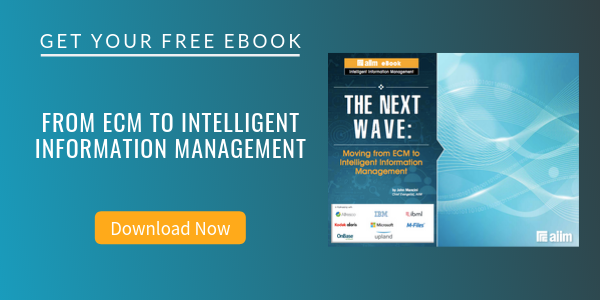
Linking the Physical and Digital Worlds – A Growing Information Management Challenge
Manufacturing | Intelligent Information Management (IIM)
One of the core issues for manufacturing companies – or for that matter, any physical asset-intensive industry -- is managing the technical information associated with the vast array of physical equipment that is needed to make the business run. It is here that the physical world (which drives the Internet of Things) truly connects with the digital world (information and content assets).
Manufacturers refer to this “asset change management” and the information management solution set associated with it is called “Asset Lifecycle Information Management.” Because the information intersection between the physical and digital worlds is: a) changing rapidly; b) directly tied to health and safety; c) critical to compliance; and d) critical to security in an age of natural disasters and terrorism, it is fraught with content management challenges.
Per LNS Research, “Whether in the public infrastructure, utilities, oil and gas, or other asset intensive industrial sectors, businesses need to rethink and redo the way they design, operate, maintain, and dispose of their assets. Today’s technology renders the traditional silo-based approaches—whether in the transition from engineering to operations groups or otherwise—an inefficient way of doing business, increasingly jeopardizing firms with a severe competitive disadvantage. The early adopters of this new paradigm can expect faster commissioning of new assets, lower operations costs due to improved asset reliability, longer asset life, and better decommissioning and disposal costs.” It is here that Digital Transformation initiatives either live or die.
6 Issues That Must Be Addressed in any Asset Lifecycle Information Management initiative
1. The state of each asset is a critical starting point.
Effective Asset Lifecycle Management begins with knowing the state of the asset. If you don’t know the state of an asset, you can’t know if the asset state has changed unless it is visibly obvious when it may be simply too late to prevent the change or mitigate its consequences. Your effectiveness will either be constrained or enabled by the completeness, timeliness, accuracy, and availability of the information regarding the state of the asset.
2. Assets are changing constantly.
If we accept that the physical assets used in a business change over time, we also accept that these assets, along with their components, systems, and operating states -- and all of the information that documents all of these -- have a history. From a change management perspective, it is important to know and record what has changed, when it was changed, who changed it, why the change was made, who approved it, and what systems and processes were impacted by the change.
3. There are interdependencies between assets.
Asset Lifecycle Management requires an understanding of the interdependencies that exist among not only the components, systems, documentation, and performance of the asset, but also among the associated people, organizations, and locations that use the asset. Changes to an asset, whether unintended or intentional, propagate throughout the asset and the asset information.
4. The volume of information that must be managed can be overwhelming.
The sheer quantity of information associated with an infrastructure asset can be overwhelming. Completely describing an infrastructure asset requires an enormous amount of information – design documents, test reports, inspection reports, specifications, standards, regulations, licenses, procedures, supplier information, contracts, as-built information, performance data, maintenance history, and on and on.
5. Be prepared for a wide variety of file types and formats.
In addition to being extremely large, the universe of asset information is incredibly diverse. It invariably includes structured and unstructured data in a multitude of formats. This diversity spans multiple formats for documents, drawings, requirements, schedules, models, images, databases, application- specific files, engineering analyses, and more. Even paper drawings and documents can be relevant. In some cases, the information contained in a particular file or database may be unintelligible except in the context of the design-oriented software application that originally created the information, which is typically an application that has no relevance to the actual operation of the asset.
6. You will face a variety of user requirements that sometimes conflict.
Finally, asset information must be directly usable by a diverse set of people with widely varying roles within the context of an operating infrastructure asset. To be “usable,” it is preferable that information about a physical asset be presented in a form, scope, and format relevant to the context of each role and its requirements for information in terms of scope, structure, level of detail, and format.
Asset Lifecycle Information Management It's a concept of direct relevance to any industry with lots of physical equipment that must be managed, but also one that I think can be expanded as we think about the implications of the Internet of Things.
About John Mancini
John Mancini is the President of Content Results, LLC and the Past President of AIIM. He is a well-known author, speaker, and advisor on information management, digital transformation and intelligent automation. John is a frequent keynote speaker and author of more than 30 eBooks on a variety of topics. He can be found on Twitter, LinkedIn and Facebook as jmancini77. Recent keynote topics include: The Stairway to Digital Transformation Navigating Disruptive Waters — 4 Things You Need to Know to Build Your Digital Transformation Strategy Getting Ahead of the Digital Transformation Curve Viewing Information Management Through a New Lens Digital Disruption: 6 Strategies to Avoid Being “Blockbustered” Specialties: Keynote speaker and writer on AI, RPA, intelligent Information Management, Intelligent Automation and Digital Transformation. Consensus-building with Boards to create strategic focus, action, and accountability. Extensive public speaking and public relations work Conversant and experienced in major technology issues and trends. Expert on inbound and content marketing, particularly in an association environment and on the Hubspot platform. John is a Phi Beta Kappa graduate of the College of William and Mary, and holds an M.A. in Public Policy from the Woodrow Wilson School at Princeton University.



